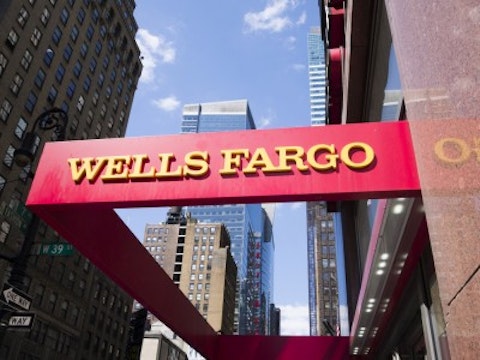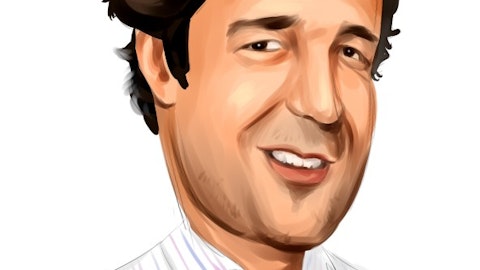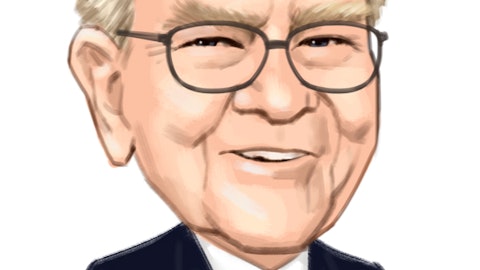Bireme Capital recently released its Q1 2020 Investor Letter, a copy of which you can download below. In the letter, the hedge fund said that its flagship U.S. equity strategy, Fundamental Value, returned -26.4% on a net basis. The fund underperformed its benchmark, the S&P 500 Index which returned -19.4% in the same quarter. You should check out Bireme Capital’s top 5 stock picks for investors to buy right now, which could be the biggest winners of the stock market crash. There weren’t a lot of funds who could deliver these kinds of returns without shorting the market or using aggressive put options.
In the said letter, Bireme Capital highlighted a few stocks and Wells Fargo & Company (NYSE:WFC) is one of them. Wells Fargo is a financial services company. Year-to-date, Wells Fargo & Company (NYSE:WFC) stock lost 55.1% and on May 22nd it had a closing price of $24.17. Here is what Bireme Capital said:
“We added two positions in the quarter. One of them was megabank Wells Fargo.
The COVID-19 crisis caused a lot of pain for bank investors during the first quarter, and Wells Fargo was no exception. In fact, the stock was dropping even before the virus reached NYC, down about 13% in January while the broader market was flat. WFC then proceeded to fall 47% to its lows on the year around $25. We invested towards the end of the quarter, with an average price of ~$27.50.
What we saw in Wells Fargo was a bank with a long history of solid, growing earnings that is facing a number of short- to medium-term problems:
- Business-practice issues of its own making.
- Potential COVID-19 related loan losses.
- Falling interest rates.
We could fill many pages with discussion of the firm’s client relations and HR scandals — opening accounts for clients without their permission, putting wealth management clients in unsuitable investment products, failing to respond to HR complaints, gender bias in hiring and promotion, illegally repossessing borrower motor vehicles, etc. The market has punished the stock since these issues came to light, with WFC underperforming peers by 50% since 2015.
Wells Fargo today reminds us of Facebook in Q4 2018 (which we wrote about here). In both cases, investors unduly shunned a fundamentally sound company that made mistakes involving breaches of customer trust. While admittedly reprehensible, the scandals at both FB and WFC are more impactful to social media sentiment than to long-term free cash flows.
Availability bias causes human beings to place disproportionate weight on this type of story. Breaches of customer trust rightfully disgust the public, and investors find it distasteful to be long a company whose CEO is chastised by Congress. Our investment strategy is predicated on identifying and exploiting these investor biases; we thrive on situations where short-term issues obfuscate the underlying health and long-term earnings power of a business.
The vast majority of revenue for Wells Fargo is generated by interest on loans, and we don’t see much evidence that the long-term volume or credit quality of these loans have been affected by the scandals of the past three years.
In fact, Wells Fargo’s relationship with consumers and businesses appears to be healthy. All of the following key metrics are flat-to-up since 2016: loans (flat), deposits (flat), customer checking accounts (+3%), debit card purchase volume (+21%), consumer card purchase volume (+17%), commercial card purchase volume (+28%), and branch visit satisfaction score (+3%). But even these figures understate the health of WFC’s business: the lack of growth in the loan book is due entirely to an asset cap put in place by regulators to punish the company for its transgressions. If not for that cap, loans and deposits would almost certainly have grown.
For this 168-year-old franchise, we paid less than 7 times trailing earnings.
We do expect those earnings to fall in the short term as COVID-19-related loan loss provisions hit the income statement. However, WFC’s balance sheet and core profitability provides plenty of margin to absorb these losses. Wells Fargo’s net charge-offs peaked at 2.2% of average loans outstanding during the financial crisis. While this level of net charge-offs would’ve been enough to wipe out last year’s earnings, it would not have impaired the firm’s book equity (assuming that dividends and buybacks were suspended temporarily).
Our base case is that the current crisis will be extremely sharp in the short term, but not worse than the financial crisis in the long term vis-à-vis unemployment, home prices, and loan defaults.
For one, consumers are in a better position. In 2008, debt service payments (mostly due to high mortgage payments) were over 13% of disposable income. Today, that number is below 10%. US households’ equity in their homes has doubled since year-end 2008, to almost $20 trillion today. Second, the banking sector — whose meltdown exacerbated if not caused the 2008 crisis — is much better capitalized, with Tier 1 common equity ratios up from about 8% in 2007 to 12% today.2
Interest rates have fallen substantially — mortgage rates, for example, have fallen by about half a percent in the last year — and thus Wells Fargo will generate less net interest income. Current Street estimates are for $43.9b in net interest income, a decline of $3.3b versus 2019. Given that lower interest rates are prevalent across the yield curve, we expect this to continue for the foreseeable future.
However, we believe Wells Fargo has a significant opportunity to offset much of that lost income by cutting costs. The firm’s “efficiency ratio,” the ratio of non-interest expenses to revenue, has become one of the worst in the industry in recent years. Partly this is due to the firm’s regulatory problems, which we estimate have cost $5b per year in legal fees, settlements, and compliance costs. As they put these issues behind them, we think they should be able to achieve an efficiency ratio similar to their peers at JP Morgan and Bank of America. This implies they may be able to shed $8-10b of total costs, which would more than offset the lost interest income from lower rates. Management has stated that they are focused on this task.
Over time, we estimate that WFC will be able to generate about $15-18b of profits per year, only slightly lower than the $18-20b they generated between 2017 and 2019. The stock trades at 6-7.5x the new earnings level, which we find quite cheap given the long-term stability of the business and the stickiness of client accounts.”

In Q4 2019, the number of bullish hedge fund positions on Wells Fargo & Company (NYSE:WFC) stock increased by about 18% from the previous quarter (see the chart here), so a number of other hedge fund managers seem to agree with WFC’s growth potential. Our calculations showed that Wells Fargo & Company (NYSE:WFC) isn’t among the 30 most popular stocks among hedge funds.
The top 10 stocks among hedge funds returned 185% since the end of 2014 and outperformed the S&P 500 Index ETFs by more than 109 percentage points. We know it sounds unbelievable. You have been dismissing our articles about top hedge fund stocks mostly because you were fed biased information by other media outlets about hedge funds’ poor performance. You could have doubled the size of your nest egg by investing in the top hedge fund stocks instead of dumb S&P 500 ETFs. Below you can watch our video about the top 5 hedge fund stocks right now. All of these stocks had positive returns in 2020.
Video: Top 5 Stocks Among Hedge Funds
At Insider Monkey we leave no stone unturned when looking for the next great investment idea. For example Europe is set to become the world’s largest cannabis market, so we check out this European marijuana stock pitch. We believe electric vehicles and energy storage are set to become giant markets, and we want to take advantage of the declining lithium prices amid the COVID-19 pandemic. So we asked astrophysicist Neil deGrasse Tyson about Tesla, Elon Musk, and his top stock picks. We read hedge fund investor letters and listen to stock pitches at hedge fund conferences. Our best call in 2020 was shorting the market when S&P 500 was trading at 3150 after realizing the coronavirus pandemic’s significance before most investors. You can subscribe to our free enewsletter below to receive our stories in your inbox:
Disclosure: None. This article is originally published at Insider Monkey.



